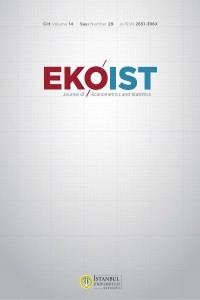KREDİ HACMİ ARTIŞININ CARİ AÇIĞA ETKİSİ: ÇOKLU YAPISAL KIRILMALI EŞBÜTÜNLEŞME ANALİZİ
Bu çalışmada, Türkiye'deki yurtiçi toplam kredi hacmi ile cari işlemler açığı arasındaki ilişki, 1992Q1-2012Q3 dönemi verileri kullanılarak, Carrion-i-Silvestre (2009) çoklu yapısal kırılmalı birim kök testi ve Maki (2012) çoklu yapısal kırılmalı eşbütünleşme yöntemiyle araştırılmıştır. Elde edilen bulgulara göre; yurtiçi toplam kredi hacmi artışıyla cari işlemler açığı arasında, eşbütünleşmenin varlığı tespit edilmiş ve yurtiçi kredi hacmindeki artışın, cari işlemler açığını arttırıcı bir faktör olduğu görülmüştür. Hata düzeltme modelinde ise, uzun dönemde birlikte hareket eden seriler arasında kısa dönem sapmalarının ortadan kalktığı gözlenmiştir.
Anahtar Kelimeler:
Cari Açık, Yurtiçi Kredi Hacmi, Çoklu Yapısal Kırılmalı Eşbütünleşme Analizi
-
-
Keywords:
Current Account Deficit, Domestic Credit Volume, Cointegration with Multiple Structural Breaks,
___
- Bai, J., Perron, P. 2003. Computation and Analysis of Multiple Structural Change Models. Journal of Applied Econometrics. 18: 1-22.
- Barisitz, S. 2003. The Transformation of the Romanian Financial and Banking Sector. Financial Stability Report 7: 88-797.
- Carrion-i-Silvestre, J. L., Kim, D ve Perron, P. 2009. GLS-Based Unit Root Tests with Multiple Structural Breaks Under Both the Null and the Alternative Hypotheses.Econometric Theory. 25: 1754-1792.
- Corsetti, G., Pesenti, P ve Roubini, N. 1999. Paper Tigers? A Model of the Asian Crisis. European Economic Review 43(7):1211-1236.
- Dymski, G. A. 2009. Why The Subprime Crisis is Different:A Minskyian Approach. Cambridge Journal of Economics 34(2):239-255.
- Enders, W. 1995. Applied Econometric Time Series. 1 st Edition, New York: Wiley.
- Enders, W. 1996. Rats Handbook for Econometric Time Series. JohnWilley and Song Inc.
- Esteve, V. ve Requena, F. 2006. A Cointegration Analysis of Car Advertising and Sales Data in the Presenceof Structural Change. International Journal of the Economics of Business. 13(1): 111-128.
- Freund, C. L. 2000. Current Account Adjustment in Industrialized Countries, Board of Governers of the FED International Finance, Discussion Papers, 692.
- Gregory, A. W. ve Hansen, B. E. 1996. Residual-Based Tests for Cointegration in Models With Regime Shifts.Journal of Econometrics. 70(1): 99-126.
- Gujarati, D, N. 1999. Basic Econometrics. Mc Graw Hill.3rd Edition. İstanbul: Literatür Yayıncılık.
- Hatemi-J, A. 2008. Tests For Cointegration With Two Unknown Regime Shifts With an Application to Financial Market Integration. Empirical Economics. 35: 497-505.
- Hoshi,T., Kashyap, A., Scharfstein, D. 1991. Corporate Structure, Liquidity, and Investment: Evidence From Japanese Industria Lgroups, Quarterly Journal of Economics, 106(1): 33-60.
- IMF, 2009. Lessons for Monetary Policy From Asset Price Fluctuation. Chapter 3 in World Economic Outlook, October.
- Kasa, K. 1998. Borrowing Constraints and Asset Market Dynamics: Evidence From Pacific Basin. Federal Reserve Bank of San Francisco Economic Review, (3): 17-28.
- Kavcıoğlu, Ş. 2012. Kriz dönemleri sonrasında Türk bankacılık sektöründe kredi analizi (2002-2011 dönemi) Finansal Araştırmalar ve Çalışmalar Dergisi, 3(6): 22-39.
- Kiyotaki, N. ve Moore, J. 1997. Credit Cycles. Journal of Political Economy. 105(2): 211-248. Krugman, P. 1998. What Happened to Asia, http://www.bresserpereira.org.br/Terceiros/ Cursos/
- Krugman-WhatHappenToAsia.pdf,
- [Erişim Tarihi: 12.10.2010]
- Kunieda, T. ve Shibata, A. 2005. Credit Constraints and the Current Account: A Test For the Japanese Economy. Journal of International Money and Finance, 24: 1261-1277.
- Kunt, D. Demirgüç, A. ve Detragiache, E. 1997. The Determinants of Banking Crises: Evidence from Developing and Developed Countries. IMF Working Paper, 106.
- Lee, J. ve Strazicich, M. C. 2003. Minimum Lagrange Multiplier Unit Root Test With Two Structural Breaks. The Review of Economics and Statistics. 85(4): 1082-1089.
- Lumsdaine, R. L. ve Papell, D. H. 1997. Multiple Trend Breaks and The Unit Root Hypothesis. The Review of Economics and Statistics. 79: 212-218.
- Maki, D. 2012. Tests For Cointegration Allowing For an Unknown Number of Breaks. Economic Modelling. 29(5): 2011-2015.
- Moreno, R. 2007. Experiences With Current Account Deficits in Southeast Asia. Working Papers Central Bank of Chile: 452 Central Bank of Chile
- Motonishi, T. ve Yoshikawa, H. 1999. Causes of the Long Stagnation of Japan During the 1990s: Financial or Real? Journal of the Japanese and International Economies. 13(3): 181-200.
- Ng, S. ve Perron, P. 2001. Lag Length Selection and the Construction of Unit Root Tests with Good Size and Power.Econometrica. 69: 1519-1554.
- Ouanes, A. ve Thakur, S. M. 1997. Macroeconomic Accountig and Analysis in Transition Economies. IMF, Washington.
- Paasche, B. 2001. Credit Constraints and International Financial Crises. Journal of Monetary Economics, 48: 623-650.
- Perron, P. 1989. The Great Crash, The Oil Price Shock, and The Unit Root Hypothesis. Econometrica. 57(2): 1361-1401.
- Perron, P. 1997. Further Evidence on Breaking Trend Functions in Macroeconomic Veriables. Journal of Econometrics. 80: 355-385.
- Stock, J. ve Watson, M. W. 1993. A Simple Estimator of Cointegrating Vectors in Higher Order Integrated Systems.Econometrica, 61(4): 783-820.
- TCMB, 2010. Finansal İstikrar Raporu: Sayı: 11. Aralık-2010, www.tcmb.gov.tr, [Erişim Tarihi: 11.05.2011]
- Teletar, E. 2011. Türkiye’de Cari Açık Belirleyicileri ve Cari Açık - Krediler ilişkisi Bankacılar Dergisi, 78: 22-35.
- Trehan, B., Walsh, C. E., 1991. Testing Intertemporal Budget Constraints: Theory and Applications to U. S. Federal Budget and Current Account Deficits. Journal of Money, Credit and Banking, 23(2): 206-223.
- Tornel, A. 1999. Common Fundamentals in the Tequila and Asian Crises. NBER Working Paper, No: 7139.
- Zivot, E. ve Andrews, D. 1992. Further Evidence on the Great Crash, the Oil-Price Shock and the Unit-Root Hypothesis. Journal of Business Economic Statistics. 10(3): 251- 270.
- Yayın Aralığı: Yılda 2 Sayı
- Yayıncı: İstanbul Üniversitesi
Sayıdaki Diğer Makaleler
İsmail KÜÇÜKAKSOY, Selcan ÖNAL
TÜRKİYE’DE KADINLARIN İŞGÜCÜNE KATILIMILARININ KOHORT ANALİZİ
KREDİ HACMİ ARTIŞININ CARİ AÇIĞA ETKİSİ: ÇOKLU YAPISAL KIRILMALI EŞBÜTÜNLEŞME ANALİZİ
İsmet GÖÇER, Mehmet MERCAN, Osman PEKER
TÜRKİYE CUMHURİYET MERKEZ BANKASI BAĞIMSIZLIĞI DEZENFLASYONİST ETKİ YARATIR MI?
YÜKSEKÖĞRETİMDE HİZMET KALİTESİ ÖLÇEĞİ: GÜVENİLİRLİK VE GEÇERLİLİK ANALİZİ
